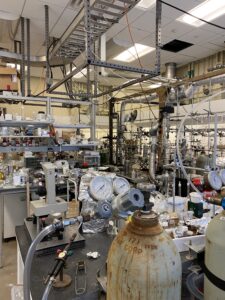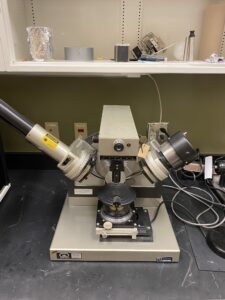Hello, my name is Logan Stephens and over the next six weeks, I will be doing my internship in the chemistry department at the University of Houston. I arrived last Friday along with my Grandpa, who showed me around Houston and made sure I was well oriented with the city, and also with my host family. Monday was my first day, and it was certainly an interesting one. Upon arriving on campus, I realized how massive the university actually was, and it took me a while to find where was I supposed to go. When I finally found the lab, my mentor, Dr. Baldelli, gave me an in-depth tour and I was absolutely stunned by their facilities.
Chemical Lab
He then introduced to the rest of his team, a mixed group of both grad and post-grad students, all of which had their own thesis projects. They were all very helpful in showing me the ropes and put me to work right away. One of the first things they showed me was a process called micro-contact printing. Micro-contact printing (MCP) simply put, is stamping a very thin layer of molecules, called a self-assembled microlayer (SAM) onto a metal slide of some sort. In my case, I used a silicon stamp which I then coated with a chemical called ODT (1-Octadecanethiol) onto a stamp with pre-etched patterns, each differing in-depth, from 1-100 nanometers. The stamp is then placed on a glass slide with a thin gold surface so that the ODT molecules may be stamped on the slide in the same pattern on the silicone. This process was very interesting to me, as I had never done anything near as complex and precise back in the high school lab, but it turns out it was only to prepare the material for the actual project.
The next day, Dr. Baldelli took me and the other members of the group and outlined what my project would be for the summer. From what I understand, we will be studying the SAMs on the slide under the presence of different amounts of electrical current. This will be done by placing the slide in an electrolytic cell and applying different levels of voltage, where we can then study the effect the voltage has using an ellipsometer. An ellipsometer is a device that measures different values of polarized light based on how they reflect off a surface. These values can then be fit to a mathematical model, and based on this model, the thickness of the surface can then be calculated.
Gaertner L116B Ellipsometer
Over the course of this project, the professor hopes to gain more insight into the nature of the bond between the thiol (sulfur) and the metal surface, as the data he has gained over the years still fails to yield a concrete explanation of the perplexing nature of this bond. Though I have only spent two days in the lab, I have already learned so much and I am very eager and excited to learn more throughout the rest of my internship.



Awesome!